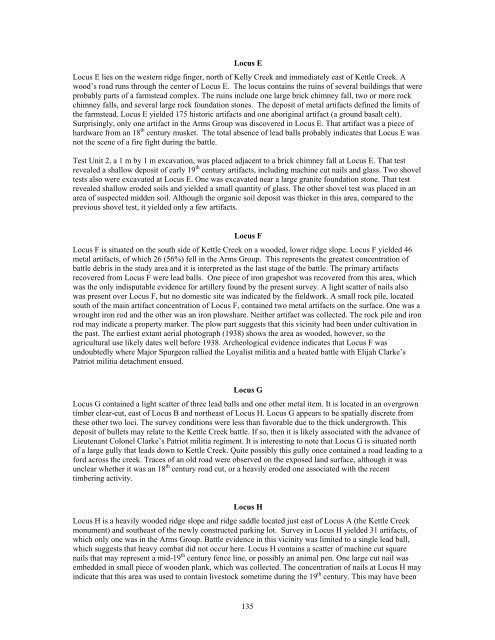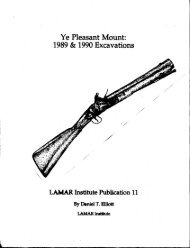Stirring Up a Hornet's Nest: - UGA Laboratory of Archaeology ...
Stirring Up a Hornet's Nest: - UGA Laboratory of Archaeology ...
Stirring Up a Hornet's Nest: - UGA Laboratory of Archaeology ...
You also want an ePaper? Increase the reach of your titles
YUMPU automatically turns print PDFs into web optimized ePapers that Google loves.
Locus E<br />
Locus E lies on the western ridge finger, north <strong>of</strong> Kelly Creek and immediately east <strong>of</strong> Kettle Creek. A<br />
wood’s road runs through the center <strong>of</strong> Locus E. The locus contains the ruins <strong>of</strong> several buildings that were<br />
probably parts <strong>of</strong> a farmstead complex. The ruins include one large brick chimney fall, two or more rock<br />
chimney falls, and several large rock foundation stones. The deposit <strong>of</strong> metal artifacts defined the limits <strong>of</strong><br />
the farmstead. Locus E yielded 175 historic artifacts and one aboriginal artifact (a ground basalt celt).<br />
Surprisingly, only one artifact in the Arms Group was discovered in Locus E. That artifact was a piece <strong>of</strong><br />
hardware from an 18 th century musket. The total absence <strong>of</strong> lead balls probably indicates that Locus E was<br />
not the scene <strong>of</strong> a fire fight during the battle.<br />
Test Unit 2, a 1 m by 1 m excavation, was placed adjacent to a brick chimney fall at Locus E. That test<br />
revealed a shallow deposit <strong>of</strong> early 19 th century artifacts, including machine cut nails and glass. Two shovel<br />
tests also were excavated at Locus E. One was excavated near a large granite foundation stone. That test<br />
revealed shallow eroded soils and yielded a small quantity <strong>of</strong> glass. The other shovel test was placed in an<br />
area <strong>of</strong> suspected midden soil. Although the organic soil deposit was thicker in this area, compared to the<br />
previous shovel test, it yielded only a few artifacts.<br />
Locus F<br />
Locus F is situated on the south side <strong>of</strong> Kettle Creek on a wooded, lower ridge slope. Locus F yielded 46<br />
metal artifacts, <strong>of</strong> which 26 (56%) fell in the Arms Group. This represents the greatest concentration <strong>of</strong><br />
battle debris in the study area and it is interpreted as the last stage <strong>of</strong> the battle. The primary artifacts<br />
recovered from Locus F were lead balls. One piece <strong>of</strong> iron grapeshot was recovered from this area, which<br />
was the only indisputable evidence for artillery found by the present survey. A light scatter <strong>of</strong> nails also<br />
was present over Locus F, but no domestic site was indicated by the fieldwork. A small rock pile, located<br />
south <strong>of</strong> the main artifact concentration <strong>of</strong> Locus F, contained two metal artifacts on the surface. One was a<br />
wrought iron rod and the other was an iron plowshare. Neither artifact was collected. The rock pile and iron<br />
rod may indicate a property marker. The plow part suggests that this vicinity had been under cultivation in<br />
the past. The earliest extant aerial photograph (1938) shows the area as wooded, however, so the<br />
agricultural use likely dates well before 1938. Archeological evidence indicates that Locus F was<br />
undoubtedly where Major Spurgeon rallied the Loyalist militia and a heated battle with Elijah Clarke’s<br />
Patriot militia detachment ensued.<br />
Locus G<br />
Locus G contained a light scatter <strong>of</strong> three lead balls and one other metal item. It is located in an overgrown<br />
timber clear-cut, east <strong>of</strong> Locus B and northeast <strong>of</strong> Locus H. Locus G appears to be spatially discrete from<br />
these other two loci. The survey conditions were less than favorable due to the thick undergrowth. This<br />
deposit <strong>of</strong> bullets may relate to the Kettle Creek battle. If so, then it is likely associated with the advance <strong>of</strong><br />
Lieutenant Colonel Clarke’s Patriot militia regiment. It is interesting to note that Locus G is situated north<br />
<strong>of</strong> a large gully that leads down to Kettle Creek. Quite possibly this gully once contained a road leading to a<br />
ford across the creek. Traces <strong>of</strong> an old road were observed on the exposed land surface, although it was<br />
unclear whether it was an 18 th century road cut, or a heavily eroded one associated with the recent<br />
timbering activity.<br />
Locus H<br />
Locus H is a heavily wooded ridge slope and ridge saddle located just east <strong>of</strong> Locus A (the Kettle Creek<br />
monument) and southeast <strong>of</strong> the newly constructed parking lot. Survey in Locus H yielded 31 artifacts, <strong>of</strong><br />
which only one was in the Arms Group. Battle evidence in this vicinity was limited to a single lead ball,<br />
which suggests that heavy combat did not occur here. Locus H contains a scatter <strong>of</strong> machine cut square<br />
nails that may represent a mid-19 th century fence line, or possibly an animal pen. One large cut nail was<br />
embedded in small piece <strong>of</strong> wooden plank, which was collected. The concentration <strong>of</strong> nails at Locus H may<br />
indicate that this area was used to contain livestock sometime during the 19 th century. This may have been<br />
135










